LIFE SCIENCES P2 2023 Section A Question1.1-1.9
Activity Summary
0 of 12 Questions completed
Questions:
Information
You have already completed the activity before. Hence you can not start it again.
Activity is loading…
You must sign in or sign up to start the activity.
You must first complete the following:
Results
Results
0 of 12 Questions answered correctly
Your time:
Time has elapsed
You have reached 0 of 0 point(s), (0)
Earned Point(s): 0 of 0, (0)
0 Essay(s) Pending (Possible Point(s): 0)
| Average score |
|
| Your score |
|
Categories
- Not categorized 0%
| Pos. | Name | Entered on | Points | Result |
|---|---|---|---|---|
| Table is loading | ||||
| No data available | ||||
- 1
- 2
- 3
- 4
- 5
- 6
- 7
- 8
- 9
- 10
- 11
- 12
- Current
- Review / Skip
- Answered
- Correct
- Incorrect
-
Question 1 of 12
1. Question
1.1 Various options are provided as possible answers to the following questions.
Choose the answer and write only the letter (A–D) next to the question
numbers (1.1.1 to 1.1.9) in the ANSWER BOOK, e.g. 1.1.10 D.
This is the instructions you will find in your exam question paper.
For this practice select the correct answer and click the check button. Use the images and the exaplnation to improve your knowledge.1.1.1 According to Lamarck’s theory for evolution, …
CorrectIncorrectHint
-
Question 2 of 12
2. Question
1.1.2 The genotype for a specific characteristic …
CorrectIncorrectHint
-
Question 3 of 12
3. Question
1.1.3 After the discovery of a fossil, scientists classified it as an
African ape because it had a …CorrectIncorrectHint
-
Question 4 of 12
4. Question
1.1.4 The statements below describe the steps in the process of cloning
an animal.
(i) The embryo is implanted into the uterus of an adult female for
development.
(ii) The nucleus from a somatic cell of the donor is extracted.
(iii) The nucleus from the somatic cell is inserted into the ovum.
(iv) The nucleus from the ovum of another individual is removed.
(v) The ovum with the new nucleus is given an electric shock to
stimulate cell division and the formation of the embryo.CorrectIncorrectHint
-
Question 5 of 12
5. Question
1.1.5 Shrubs of the family Proteaceae (e.g. Waratahs and proteas) can
be found in Australia, South America, Indo-China and parts of
Africa as shown on the map below.
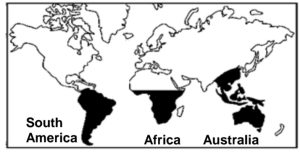
It is hypothesised that all continents were once one large continent
called Pangaea and that they separated due to continental drift.
This is evidence that the family Proteaceae …CorrectIncorrectHint
-
Question 6 of 12
6. Question
1.1.6 The diagram below shows the DNA profiles of a girl, her mother
and four males.
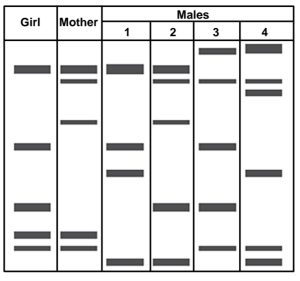
Which male is the girl’s biological father?CorrectIncorrectHint
-
Question 7 of 12
7. Question
1.1.7 The following are characteristics of a group of animals:
(i) Able to interbreed
(ii) Occupy the same habitat
(iii) Produce infertile offspring
(iv) Belong to the same species
Which combination CORRECTLY represents a population?CorrectIncorrectHint
-
Question 8 of 12
8. Question
1.1.8 During Anaphase II of meiosis, the two chromatids of a
chromosome are pulled apart, each moving towards opposite poles
at a rate of 1 micrometre per second.
The distance, in micrometres, between the chromatids after
20 seconds is …CorrectIncorrectHint
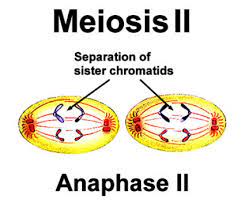
each chromatid is moving towards opposite pole
at a rate of 1 micrometre per second. -
Question 9 of 12
9. Question
1.1.9 Which ONE of the following indicates the type of variation for each
of the human characteristics given?
 CorrectIncorrect
CorrectIncorrectHint
-
Question 10 of 12
10. Question
1.3 Indicate whether each of the descriptions in COLUMN I apply to A ONLY,
B ONLY, BOTH A AND B or NONE of the items in COLUMN II. Write A only,
B only, both A and B or none next to the question numbers (1.3.1 to 1.3.3)
in the ANSWER BOOK. This is how you will answer in the exam. For this practice just select the correct answer and click the Check button.1.3.1
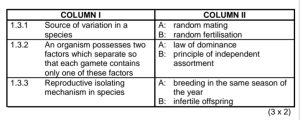 CorrectIncorrect
CorrectIncorrectHint
-
Question 11 of 12
11. Question
1.3.2
 CorrectIncorrect
CorrectIncorrectHint
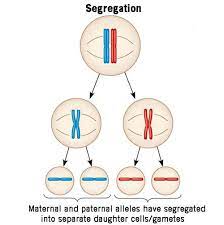
Law of segregation. -
Question 12 of 12
12. Question
1.3.3
 CorrectIncorrect
CorrectIncorrectHint
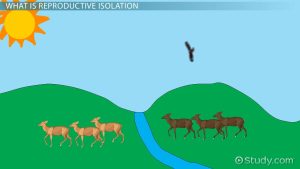
What happen to a species if there is a mechanism that separate them ?

